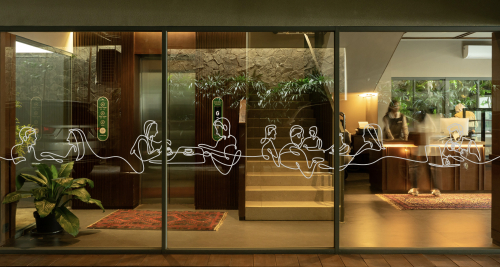SOLIPSISME DE DUPLICHATTE: An Introduction to the Doppelgänger of Nadine Hanisya
Designer: Nadine Hanisya
Scope: Publication
Publisher: Tiny Studio
Amid the Saturday afternoon bustle of this year’s Press Print Party, Nadine Hanisya of Tiny Studio introduced us to Duplichatte, a life-sized doll that closely resembles Nadine herself, its creator. Our curiosity about the figure perched on Tiny Studio’s table led us to flip through the pages of SOLIPSISME DE DUPLICHATTE, a visual diary chronicling the journey of Nadine and her “doppelgänger” in search of the self–and of a place where they can fully be that self.
“I am not her. I am what she left behind. A bag of childhood memories, fossils of tenderness and fear intertwined, that she could not let go of.”
Nadine once shared that Duplichatte was a project she developed while living in France. In the introduction written by Ula Zuhra, Duplichatte is described as a projection of Nadine herself–an embodiment of everything her body could not express or contain. Duplichatte serves both as a mirror and a shield, allowing Nadine to process and understand her emotions. In a tangible form, even pain can be seen, then understood.
Though physically manifested, Duplichatte remains an abstract concept–perhaps strange to many–and, like most journeys of self-discovery, inherently messy. All these values are carefully translated into the design of SOLIPSISME DE DUPLICHATTE, allowing us, once unfamiliar with Duplichatte’s existence, to enter the imaginative world Nadine has built for her “doppelgänger.”
From the moment we held SOLIPSISME DE DUPLICHATTE, the cover immediately drew us in. A lenticular photo of Nadine and Duplichatte alternates between the two figures–appearing and disappearing, reinforcing the duality that lies at the core of this project. The book’s title appears faintly, embossed as texture rather than text, compelling us to focus on the image and ask: who is this figure that looks just like Nadine?
Beyond the cover, the design of SOLIPSISME DE DUPLICHATTE seems to mirror the journey of a young woman coming to know herself; full of confusion, overlap, and yet deeply sincere. Turning each page feels like stepping into a teenage girl’s bedroom: layered with textures, patterns, and unpredictable compositions. Nothing feels stable or uniform, and perhaps that’s exactly where its artistic strength lies.
The visual arrangements evoke bursts of emotion: flashes of anger, quiet sadness, and subtle growth–mirroring the emotional turbulence of girlhood, filled with questions and contradictions. Our eyes are guided through fiery motifs amid archival images, before landing on softer, bluer pages that feel reflective–echoing the emotional shifts of adolescence. The section titled “The Process” is presented in a deliberately raw manner, printed on a different, rougher type of paper, like the pages of a private journal never meant to be shared. Within it, archival photographs feel like Nadine’s own space for reflection; an honest and intimate closing chapter where she looks back on the act of creating herself through “doppelgänger.”
We also recognize that this book isn’t for everyone, both in its context and its design. For some, the visual journey may feel overwhelming: the eyes are constantly asked to navigate a multitude of textures, rhythms, and emotions that never settle. But perhaps that’s precisely the journey Nadine and Duplichatte undergo–confusing, unstable, yet within that chaos lies the purest form of self-discovery.
It’s also important to note that this book cannot be fully experienced in isolation–it stands alongside a series of cross-medium artworks that Nadine created as the foundational layers of Duplichatte’s story. So, as the book suggests: watch the videos, read the poems, and don’t miss a single photographic frame shaped by Nadine’s artistic direction. Only then will you realize that Duplichatte is a complex being, born from emotions even more complex–and understand why the design of SOLIPSISME DE DUPLICHATTE embraces that very complexity.

















